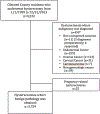Incidence of sarcoma in patients undergoing hysterectomy for benign indications: a population-based study
- PMID: 30447212
- PMCID: PMC7118695
- DOI: 10.1016/j.ajog.2018.11.1086
Incidence of sarcoma in patients undergoing hysterectomy for benign indications: a population-based study
Abstract
Background: Minimally invasive hysterectomy may require the use of morcellation to remove the uterus. In the presence of unexpected sarcoma, morcellation risks disseminating malignant cells and worsening survival outcomes. As a consequence, in 2014 the US Food and Drug Administration issued a black box warning against the use of power morcellator for the treatment of uterine fibroids. However, the proportion of unexpected sarcoma at the time of hysterectomy for presumed benign indication remains unclear.
Objective: The objective of the study was to estimate the incidence of sarcoma among women undergoing hysterectomy for benign indication in Olmsted County, MN, between 1999 and 2013.
Study design: We conducted a population-based study including all hysterectomies performed for benign indication in Olmsted County women between Jan. 1, 1999, and Dec. 31, 2013. Cases were identified using the medical records-linkage system of the Rochester Epidemiology Project, and data were abstracted by a gynecologist who reviewed the complete medical records of each woman who underwent hysterectomy. An expert pathologist reviewed the pathologic slides of each sarcoma to ensure the accuracy of the diagnosis. Incidences of sarcoma (overall and by type of sarcoma) were estimated both overall and stratified by menopausal status, indication for surgery, and uterine weight as a rate per 100 persons.
Results: A total of 4232 hysterectomies were performed during the study period. Among them, we identified 16 sarcomas, of which 11 (69%) were suspected preoperatively and 5 (31%) were unexpected. Of the total number of hysterectomies, 3759 (88.8%) were performed for benign indication. Among those, the incidence of unexpected sarcoma was 0.13% (5 per 3759 [95% confidence interval, 0.04-0.31%]). Uterine fibroids comprised 27.3% of all hysterectomies for benign indication (n = 1025) and was the indication most commonly associated with diagnosis of unexpected sarcoma. The incidence of unexpected sarcoma among surgeries for uterine fibroids was 0.35% (3 of 851) for premenopausal women and 0.57% (1 of 174) for peri/postmenopausal, and all 4 unexpected sarcomas were leiomyosarcoma. The incidence of unexpected sarcoma progressively increased with higher uterine weight with an incidence of 0.03% (1 of 2993) among women with a uterine weight <250 g vs 15.4% (2 of 13) with a uterine weight ≥2000 g.
Conclusion: Unexpected uterine sarcoma was low in all women undergoing hysterectomy for benign indication (0.13% or 1 in 752 surgeries) while it was increased in women with uterine fibroids (0.39% or 1 in 256 surgeries). Peri/postmenopausal women, women with large uteri, and age ≥45 years were risk factors for sarcoma.
Keywords: Olmsted County; hysterectomy; morcellation; uterine fibroids; uterine sarcoma.
Copyright © 2018. Published by Elsevier Inc.
Conflict of interest statement
Figures
Similar articles
-
Practice Patterns and Complications of Benign Hysterectomy Following the FDA Statement Warning Against the Use of Power Morcellation.JAMA Surg. 2018 Jun 20;153(6):e180141. doi: 10.1001/jamasurg.2018.0141. Epub 2018 Jun 20. JAMA Surg. 2018. PMID: 29641835 Free PMC article.
-
Risk of Occult Uterine Sarcoma in Presumed Uterine Fibroids.Clin Obstet Gynecol. 2016 Mar;59(1):103-18. doi: 10.1097/GRF.0000000000000163. Clin Obstet Gynecol. 2016. PMID: 26645385 Review.
-
Does fibroids surgery by endoscopy or laparotomy represent a malignancy threat?Minerva Ginecol. 2017 Dec;69(6):517-525. doi: 10.23736/S0026-4784.17.04104-1. Epub 2017 Jul 10. Minerva Ginecol. 2017. PMID: 28696085
-
Prevalence, characteristics, and risk factors of occult uterine cancer in presumed benign hysterectomy.Am J Obstet Gynecol. 2019 Jul;221(1):39.e1-39.e14. doi: 10.1016/j.ajog.2019.02.051. Epub 2019 Mar 7. Am J Obstet Gynecol. 2019. PMID: 30853364 Free PMC article.
-
Reducing the spread of occult uterine sarcoma at the time of minimally invasive gynecologic surgery.Arch Gynecol Obstet. 2018 Feb;297(2):285-293. doi: 10.1007/s00404-017-4575-6. Epub 2017 Nov 11. Arch Gynecol Obstet. 2018. PMID: 29128980 Review.
Cited by
-
Contained Power Morcellation in Laparoscopic Uterine Myoma Surgeries: A Brief Review.Healthcare (Basel). 2023 Sep 7;11(18):2481. doi: 10.3390/healthcare11182481. Healthcare (Basel). 2023. PMID: 37761678 Free PMC article. Review.
-
Rethinking the Issue of Power Morcellation of Uterine Fibroids: Is Morcellation the Real Problem or Is this Another Symptom of Disparity in Healthcare Provision?In Vivo. 2019 Sep-Oct;33(5):1393-1401. doi: 10.21873/invivo.11616. In Vivo. 2019. PMID: 31471384 Free PMC article. Review.
-
The incidence of unexpected uterine malignancies in hysterectomies carried out for benign indications.J Cancer Res Clin Oncol. 2023 Jul;149(8):4339-4345. doi: 10.1007/s00432-022-04343-0. Epub 2022 Sep 9. J Cancer Res Clin Oncol. 2023. PMID: 36083311 Free PMC article.
-
Incidence and Predictors of Unexpected Malignancy in Benign Myomectomy or Hysterectomy.Cureus. 2024 Aug 14;16(8):e66880. doi: 10.7759/cureus.66880. eCollection 2024 Aug. Cureus. 2024. PMID: 39280471 Free PMC article.
-
Clinico-radio-histopathological Correlation of Leiomyoma Variant, STUMP, and Sarcoma: A Retrospective Study.Oman Med J. 2025 Jan 31;40(1):e715. doi: 10.5001/omj.2025.49. eCollection 2025 Jan. Oman Med J. 2025. PMID: 40337319 Free PMC article.
References
-
- Cohen SL, Ajao MO, Clark NV, Vitonis AF, Einarsson JI. Outpatient Hysterectomy Volume in the United States. Obstetrics and Gynecology. 2017;130(1):130–137. - PubMed
-
- D’Angelo E, Prat J. Uterine sarcomas: a review. Gynecol Oncol. 2010;116(1):131–139. - PubMed
-
- Hosh M, Antar S, Nazzal A, Warda M, Gibreel A, Refky B. Uterine Sarcoma: Analysis of 13,089 Cases Based on Surveillance, Epidemiology, and End Results Database. International Journal of Gynecological Cancer. 2016;26(6):1098–1104. - PubMed
Publication types
MeSH terms
Grants and funding
LinkOut - more resources
Full Text Sources
Medical
Research Materials


